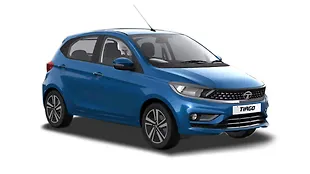Introduction
Tata’s refreshing Tiago has been garnering a lot of attention of late and we pit it against the Celerio from Maruti Suzuki’s stable before they go on to lock horns once launched. Both cars have petrol and diesel versions while the Celerio also comes with an automatic transmission.

Tata Motors proudly associates its new hatch with a fresh design language and cutting edge dynamics and we analyse how the Tiago really adds up as of now.
Looks
There’s no denying that the Tiago looks younger when you compare them in terms of design elements. It’s longer and wider than the Celerio by 146mm and 47mm and the Tiago is shorter by 25mm; even though the ground clearance is 170mm, 5mm more than the Maruti hatch. These dimensions will show you why the Tiago looks more fluid and less of a tall boy.

Tata’s Tiago sports a contemporary front end. The bonnet line edges ahead where the wide smiley grill with the huge Tata logo sharply drops down to meet the lines of the bumper and the blacked out chin holding the fog lamps. The headlamps sweep back through the bonnet, bumper and fenders lending a sharp look. Sleek alloys along with the perfectly raised window line adds depth to the side profile. The rear end flows with the rest of the design, especially the pronounced spoiler and the sharp bumper ridges flowing on to the sheet metal of the boot that holds the decently shaped tail lamps. The section holding the number plate has been blacked out till the bottom and this renders a sporty look.

After looking at the Tiago, the Celerio feels far from sporty and carries a more subdued look. Overall, the lines are subtle and less aggressive. The headlamps are split by a huge dual slat grill that holds the Suzuki logo and the blackened chin section separates the scooped fog lights on either side. The ridge that begins from the front wheel arches and flows to the tail lamp is the most prominent feature on the side profile. The thick C-pillar, six spoke alloys and high rear window line also lends some character to this hatchback. The rear end could have been given a better design as the high stance makes it feel narrower that it actually is.
Interior
It’s early to comment on whether Tata can get the length and breadth advantage of 146mm and 47mm, over the Celerio, to reflect on the interior and boot space. Especially, when the Celerio benefits from an added 25mm to the wheelbase and height which could put things in perspective.

The Tiago’s interiors are comparatively better built; the seats have superior finish and contours that could offer more feel and support when compared to the Celerio which clearly looks flatter. Fixed head restraints all around are seen on both cars. We felt more inclined towards the Tiago to offer a more concise premium feel. Both cars come equipped with front fog lamps, alloy wheels, rear parcel tray, power windows on all doors, electric mirrors, audio controls on the steering, ORVM with turn indicators, tachometer, trip computer, 2 airbags, ABS, rear wiper and a defogger.

The Celerio also sports a music system with four speakers that plays from a CD, usb, aux and supports Bluetooth. The Tiago has similar functions but drops the CD compatibility and picks up Android phone-based navigation along with a total of eight speakers. The Tiago also benefits from corner stability control as an added safety feature. This is true for the top of the line versions of both cars.

Performance
The Tata Tiago is expected to come with a 1.2-litre 3-cylinder engine that has 83bhp and 114Nm of torque, while the diesel iteration will sport a 1.05-litre 3-cylinder engine that will have 69bhp on tap with 140Nm of torque. The Celerio, on the other hand, comes with a petrol 998cc 3-cylinder that has 67bhp and 90Nm of torque along with both manual and automatic transmission, while the diesel 793cc 2-cylinder engine has an output of 47bhp and 125Nm of torque. The Tiago’s specs, by far, eclipse both the Celerio engines. It firmly states, at least on paper, that the Tiago should be more indulging to drive both in the city and on the highway across rpms. Fuel efficiency figures have not been revealed for the Tiago but the Celerio has an ARAI figure of 23.1kmpl for the petrol and 27.6kmpl for the diesel.

The Tiago will weigh an extra 200kg over the Celerio and we feel that the extra power generated by the engines could nullify the weight gain on the highway but in the city, the Tiago will return a lesser fuel efficiency figure. We expect the Tata Tiago to return around 23kmpl for the diesel and around 19kmpl for the petrol.
Verdict
When both cars are stacked up against each other, even though the Tata Tiago has an added advantage of better looks and powerful engines, it seems obvious that the Tiago may not eat into the Maruti Celerio’s pie. This, however, could change if Tata Motors can put up with a fight and price the Tiago attractively. As a consumer, it only gets better.
Update: We have replaced the name Zica with the Tiago in the text as Tata officially renamed the car.

![Tata Tiago [2016-2020] Image Tata Tiago [2016-2020] Image](https://imgd.aeplcdn.com/272x153/cw/ec/20880/Tata-Tiago-Exterior-120831.jpg?wm=0&q=80)
![Tata Tiago [2016-2020] Exterior Tata Tiago [2016-2020] Exterior](https://imgd.aeplcdn.com/199x112/cw/ec/20880/Tata-Tiago-Exterior-120831.jpg?wm=0&q=80)
![Tata Tiago [2016-2020] Right Front Three Quarter Tata Tiago [2016-2020] Right Front Three Quarter](https://imgd.aeplcdn.com/199x112/cw/ec/20880/Tata-Tiago-Right-Front-Three-Quarter-70545.jpg?v=201711021421&q=80)
![Tata Tiago [2016-2020] Right Front Three Quarter Tata Tiago [2016-2020] Right Front Three Quarter](https://imgd.aeplcdn.com/199x112/cw/ec/20880/Tata-Tiago-Right-Front-Three-Quarter-101601.jpg?v=201711021421&wm=1&q=80)
![Tata Tiago [2016-2020] Dashboard Tata Tiago [2016-2020] Dashboard](https://imgd.aeplcdn.com/199x112/cw/ec/20880/Tata-Zica-Dashboard-61428.jpg?v=201711021421&q=80)
![Tata Tiago [2016-2020] Steering Wheel Tata Tiago [2016-2020] Steering Wheel](https://imgd.aeplcdn.com/468x263/cw/ec/20880/Tata-Tiago-Steering-Wheel-101624.jpg?v=201711021421&wm=1&q=80)


























